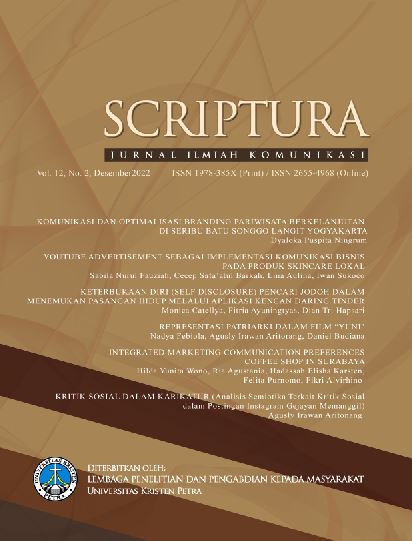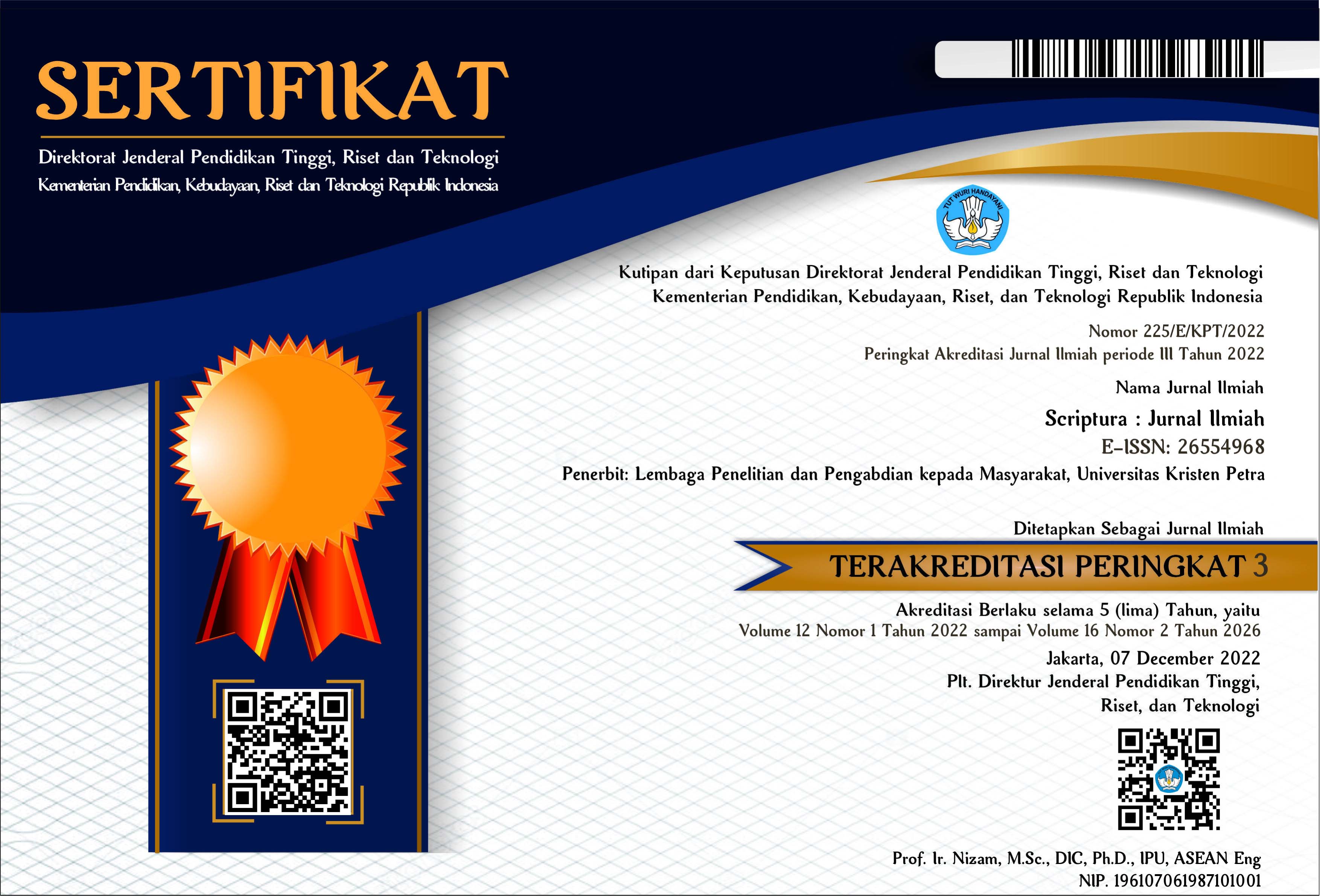KOMUNIKASI DAN OPTIMALISASI BRANDING PARIWISATA BERKELANJUTAN DI SERIBU BATU SONGGO LANGIT YOGYAKARTA
 :
:
https://doi.org/10.9744/scriptura.12.2.72-81
Keywords:
Sustainable Tourism, Branding, Seribu Batu Songgo Langit YogyakartaAbstract
Various campaigns for the rise of the tourism sector are intensified almost every time, including at the Thousand Stones Songgo Langit tourist attraction, Yogyakarta. By using destination branding theory, this research aims to explore the ins and outs of what has been done, is being done or will be done by the tour operator to further strengthen the brand and quality of the destinations offered. The communication aspect is no less important as a focus for measuring the achievement of the concept of sustainable tourism in the current era because it has a significant impact on current and future conditions. Especially in the midst of serious competition that organizers must face, so that in this case, activities related to promotion, publication and branding of a tourist destination must be packaged in such a way. By using descriptive qualitative method, the results of the study show that there is a unique brand that is indirectly successfully created by visitors at that location. However, various marketing strategies and tactics that have been carried out previously still need to be improved again. The sustainable tourism development program with all its benefits really balances the ecosystem. So that in the future, more cooperative cooperation from all levels of stakeholders is needed.
References
Ardiansyah, I., & Maulida, R. G. (2020). Kajian Atraksi, Amenitas dan Aksesibilitas untuk Pengembangan Kepariwisataan di Taman Wisa¬ta Alam Gunung Pancar Kabupaten Bogor. Jurnal Inovasi Penelitian, 1(4), 707-716.
Arida, N. S. N. S., & Sunarta, N. (2017). Buku Ajar Pariwisata Berkelanjutan. Bali : Sustain Press
Cooper. 1995. Tourism Principles & Practice. Lon-don: Longman Group Limited.
Herdiansyah, Haris. 2012. Metodologi Penelitian Kualitatif Untuk Ilmu-Ilmu Sosial. Jakarta Selatan: Salemba Humanika
Kavaratzis. 2008. From City Marketing to City Branding, An Interdisciplinary Analysis with Reference to Amsterdam, Budapest and Athens. Dissertations : University of Groningen.
Kementerian Pariwisata dan Ekonomi Kreatif / Badan Pariwisata dan Ekonomi Kreatif Republik Indo-nesia (2021). ISTC: Mendorong Percepatan Pariwisata Berkelanjutan di Indonesia. https://kemen-parekraf.go.id/ragam-pariwisata/ISTC% 3A-Mendorong-Percepatan-Pariwisata-Berke-lanjutan-di-Indonesia. Diakses Pada Tanggal 14 Januari 2022.
Kotler, Philip. 2008. Manajemen Pemasaran Edisi 12 Jilid 2. Jakarta: Indeks.
Mustikawati L., Luqman, Y., & Setiabudi, D. (2013). Strategi Branding Kota Surakarta Dalam Pengelolaan Sebagai Destinasi Wisata. Interaksi Online, 1(3).
Ningrum, D. P. (2021). Tata Kelola Kebiasaan Baru di Taman Sungai Mudal Yogyakarta (Proses Adaptasi, Sosialisasi, Partisipasi oleh Pengelola dan Pengunjung). Jurnal SCRIPTURA, 11(2), 74-84.
Nurudin. (2015). Pengantar Komunikasi Massa. Jakarta: Rajawali Pers.
Priscila, G., & Robin, P. (2021). Pengaisan Big Data & Dunia Kesehatan. PUBLIC CORNER, 16(1), 37-57.
Sharpley, R. (2000). Tourism and Sustainable Deve-lopment: Exploring the Theoretical Divice. Journal of Sustainable Tourism, VIII (1): 1-19
Soyomukti, Nurani. (2010). Pengantar Sosiologi. Yogyakarta : Ar-Ruzz Media.
Sugiama, A Gima. 2013. Manajemen Aset Pariwisata: Pelayanan Berkualitas Agar Wisatawan Puas dan Loyal. Guardaya Intimarta. Bandung, hal 65
Sugiyono. 2016. Metode Penelitian Kuantitatif Kualitatif dan R & D. Bandung: Alfabeta
Sunyoto Danang. 2012. Dasar-dasar manajemen pemasaran. Cetakan Pertama. Yogyakarta: CAPS.
Downloads
Published
How to Cite
Issue
Section
License
Copyright (c) 2023 Dyaloka Puspita Ningrum Dyaloka

This work is licensed under a Creative Commons Attribution 4.0 International License.
Authors who publish in the SCRIPTURA Jurnal Ilmiah agree to the following terms:
Authors retain unrestricted copyright and full publishing rights. The authors grant the Publisher the right of first publication, with the work simultaneously licensed under the terms and conditions of the Creative Commons Attribution License (CC BY) that allows for unlimited use, distribution, and content reproduction on all media as long as the original author and source are properly acknowledged and cited.


















